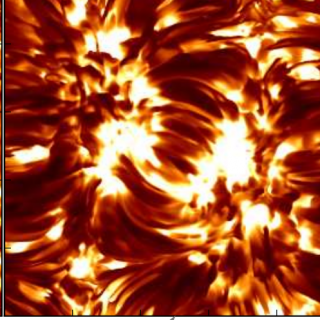Bibcode
Popescu Braileanu, B.; Lukin, V. S.; Khomenko, E.; de Vicente, Á.
Referencia bibliográfica
Astronomy and Astrophysics, Volume 627, id.A25, 18 pp.
Fecha de publicación:
7
2019
Revista
Número de citas
57
Número de citas referidas
55
Descripción
Solar chromosphere consists of a partially ionized plasma, which makes
modeling the solar chromosphere a particularly challenging numerical
task. Here we numerically model chromospheric waves using a two-fluid
approach with a newly developed numerical code. The code solves
two-fluid equations of conservation of mass, momentum, and energy,
together with the induction equation for the case of the purely hydrogen
plasma with collisional coupling between the charged and neutral fluid
components. The implementation of a semi-implicit algorithm allows us to
overcome the numerical stability constraints due to the stiff
collisional terms. We test the code against analytical solutions of
acoustic and Alfvén wave propagation in uniform medium in several
regimes of collisional coupling. The results of our simulations are
consistent with the analytical estimates, and with other results
described in the literature. In the limit of a large collisional
frequency, the waves propagate with a common speed of a single fluid. In
the other limit of a vanishingly small collisional frequency, the
Alfvén waves propagate with an Alfvén speed of the charged
fluid only, while the perturbation in neutral fluid is very small. The
acoustic waves in these limits propagate with the sound speed
corresponding to either the charges or the neutrals, while the
perturbation in the other fluid component is negligible. Otherwise, when
the collision frequency is similar to the real part of the wave
frequency, the interaction between charges and neutrals through
momentum-transfer collisions cause alterations of the waves frequencies
and damping of the wave amplitudes.
Proyectos relacionados

Simulación Numérica de Procesos Astrofísicos
La simulación numérica mediante códigos complejos de ordenador es una herramienta fundamental en la investigación física y en la técnica desde hace décadas. El crecimiento vertiginoso de las capacidades informáticas junto con el avance notable de la matemática numérica ha hecho accesible a los centros de investigación de tamaño medio
Daniel Elías
Nóbrega Siverio

Magnestismo Solar y Estelar
Los campos magnéticos son uno de los ingredientes fundamentales en la formación de estrellas y su evolución. En el nacimiento de una estrella, los campos magnéticos llegan a frenar su rotación durante el colapso de la nube molecular, y en el fin de la vida de una estrella, el magnetismo puede ser clave en la forma en la que se pierden las capas
Tobías
Felipe García

Magnetismo, Polarización y Transferencia Radiativa en Astrofísica
Los campos magnéticos están presentes en todos los plasmas astrofísicos y controlan la mayor parte de la variabilidad que se observa en el Universo a escalas temporales intermedias. Se encuentran en estrellas, a lo largo de todo el diagrama de Hertzsprung-Russell, en galaxias, e incluso quizás en el medio intergaláctico. La polarización de la luz
Ernest
Alsina Ballester